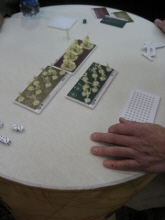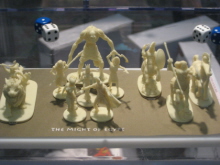
Arcane Legions
Wells Expeditions
Release Date: August 2009
Painted and unpainted plastic miniatures; plastic bases.
Designed by Jordan Weisman and Ethan Pasternack
Starter Pack $34.99
Army Pack $14.99
Cavalry Pack $14.99
Booster Pack $11.99
Coming in September from Wells Expeditions, Arcane Legions is a collectible miniatures mass-action wargame from the creators of Mage Knight, HeroClix, and MechWarrior. Players command the armies of one of three ancient civilizations, augmented by supernatural creatures with a wide range of abilities in a conflict that offers nearly endless variety.
Your first choice will be in what faction you choose to play. The game is set in 37 B.C. and offers you the option of the Roman army, commanded by Octavian; the Egyptians, commanded by Mark Antony and Cleopatra; or the mysterious Han Dynasty from the
Each card has a point value, number of figures it can support, and a number of spaces on it (usually more than the figures it can support). Each space on the card has one or more attributes attached to it: movement, attack, defense, and special abilities. When a figure is placed in a space, the entire card gains that ability. Thus, if three figures occupy movement spaces (each with one movement icon), the unit has a movement of three. If four figures occupy spaces with one attack die and two figures occupy spaces with two attack dice, the unit has a total of eight attack dice. Special abilities are located on the cards themselves, reducing the need for reference materials.
The game begins after armies are assembled on the cards in a fixed layout. Each turn, a player has five action points and three different actions he can take: reform, march, and attack. A reforming action lets you rearrange figures on a card. For example, you may want to move figures to spaces with movement icons to cover ground quickly or to attack dice icons to prepare for an attack. Think of it as the difference between a legion on the march -- strung out and not prepared for combat -- versus one assembled in line and ready for battle, but not very mobile.
Marching lets you move and maneuver a unit, using a unique tool specially designed for the game; no tape measures or other measurement devices are needed. Units can meet head on, flank each other, assist another friendly unit, or simply block each other’s progress.
An attack action orders a unit to attack. When two units clash, the attacker rolls the attack dice he’s entitled to and the defender does the same with his defense dice. Dice are compared sequentially, highest to lowest and the loser of each result takes a point of damage. For example, if the attacker rolls 6, 5, 5, 4, 1, 1 and the defender rolls 5, 5, 4, 3, 2, 1, the matchups are 6-5, 5-5, 5-4, 4-3, 1-2, and 1-1. The attacker wins three of those comparisons (6-5, 5-4, and 4-3), the defender wins one (1-2), and there are two ties (5-5 and 1-1). Thus, the defender would take three points of damage to his unit and the attacker one point of damage. Most foot soldiers and common pieces can only take one point of damage before being eliminated; larger units require multiple points of damage to eliminate.
In addition to the cards that come with the first set for the game (about 250 in total), players will be able to go online and create their own army cards, customized with whatever abilities and icons they see fit – but the point cost will reflect the card’s strength. These player-created cards will be fully legal in sanctioned tournaments and will include a unique serial number that tournament organizers can use to verify the legality of the card online, thus preventing would-be cheaters from modifying the card file’s point value or abilities before printing it out. This kind of variety means that even experienced players who have memorized every unit’s and every card’s capabilities can still face unknown challenges in every match.





